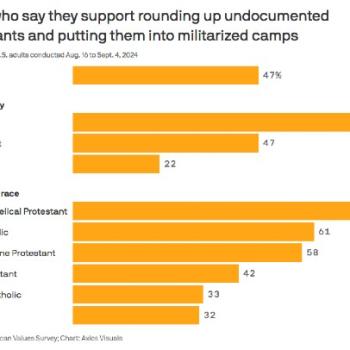We noted yesterday that President Joe Biden has raised the presidential determination for refugees from the all-time low of 15,000 up to 62,500. This is a Good Thing even though, alas, it likely will not mean that the U.S. will meet that target this year and provide refuge to 62,500 people.
The Trump administration slashed the legal limit/target for refugee resettlement to less than a tenth of what it was during the Reagan administration. This had a devastating effect not just on the people legally denied refuge, but on the American capacity for resettling refugees here. It meant massive layoffs at all of the non-profit agencies that carry out this work here in the U.S. Their staff were idled, their programs were mothballed, and it’s going to take some time for all of them to ramp back up to where they can handle 62,500 cases a year again.
Emily McFarlan Miller and Jack Jenkins had a good piece this weekend on this for RNS, “Biden raises refugee ceiling, and faith-based groups brace for rebuilding work.”
Faith-based refugee resettlement groups are celebrating President Joe Biden’s decision to raise the number of refugees allowed into the U.S. for the remainder of the federal fiscal year to 62,500, even as they acknowledge that they need to rebuild their capacity after years of cuts under the previous administration. …
That will reinforce efforts to rebuild the U.S. refugee resettlement program after cuts made by Trump, according to the statement.
It also is a step on the way to raising the refugee ceiling to 125,000 in Biden’s first full fiscal year in office, which begins in October. …
But the president also appeared careful to set expectations in his announcement.
“The sad truth is that we will not achieve 62,500 admissions this year,” he said. “We are working quickly to undo the damage of the last four years. It will take some time, but that work is already underway.”
The RNS piece focuses on the “Six of the nine agencies contracted by the U.S. government to resettle refugees [which] are faith-based: LIRS, Church World Service, HIAS (founded as the Hebrew Immigrant Aid Society), Episcopal Migration Ministries, the U.S. Conference of Catholic Bishops and World Relief.” The other three are the Ethiopian Community Development Council, the International Rescue Committee, and the US Committee for Refugees and Immigrants. They’re all scrambling to rebuild their staffs, reactivate their networks of volunteers and supporters, and to move from virtual hiatus to being ready, next year, to welcome more refugees than they have since 1992.
This is challenging work. It’s intensely particular, logistical, and individual. It means recruiting and training (and vetting) local sponsors and supporters for every one of those 125,000 “cases” — neighbors who are willing and able to help all of these folks find homes and jobs and connections to their new communities.
Given the scope of that challenge, it seems audacious to suggest — as I did here yesterday — that the official U.S. target/limit for refugee resettlement should be even higher. Or to argue, as I did, that there should be no limit, and that the target should be to welcome all of them.
To what extent is that a real possibility as opposed to a pipe dream? Well, let’s consider some numbers. The UN’s most resent estimate says there are about 71 million refugees in the world. That’s a lot more than 62,500 and a lot more than 125,000.
But keep in mind they’re not all trying to come here. Many of them aren’t looking to resettle anywhere, just to find refuge temporarily until they hope to be able to return to their homes after the war, or after the tyrant dies, or after the waters recede and the volcano settles down. The fact that there are more than 70 million refugees currently displaced and in need does not mean that all 70 million are knocking on America’s door hoping or wanting to resettle here.
How many of them are? I don’t know. And I don’t know how to know. So let’s just stipulate some number, say a tenth of them, or roughly 7 million people. If the current limit of 62,500 likely exceeds America’s capacity this year and next year’s target of 125,000 seems like an ambitious dream, then surely “we” — that word is doing an unbearable amount of work here — would not be able to welcome and resettle 7 million people. The highest single-year total America has ever achieved was the 207,116 refugees welcomed in 1980,* and even at that record pace it would take 35 years to resettle 7 million people.
So is 7 million people even possible? We could ponder that wrong question, filling the backs of envelopes with sketchy arithmetic attempting to factor in all the variables (employment, housing, population densities, the economic boost provided by millions of new consumers, workers, inventors, physicians, teachers, students, etc.). And I’d toss in the fact that we’ve already proved that we, as a nation, can welcome nearly 4 million new neighbors each year, since that’s how many births occur annually. Refugees are far easier to welcome here than those newborns, as they don’t take nearly as long to begin providing a net contribution to their communities and economies.
But it’s still the wrong question. We’re bound to keep asking wrong questions because of the way the Refugee Act of 1980 establishes our target for refugee resettlement as also our legal limit for it.
Our target — our goal or ambition — is always going to be constrained by our capacity. That capacity can, and should, be expanded — both the nuts-and-bolts logistical capacity and the moral capacity that undergirds it. We should be setting ambitious goals and straining to grow to meet them, but I’m not really advocating that these goals be off the charts. Doubling the historically below average goal of 62,500 for this year to 125,000 next year is a good step in the right direction. I’d like to see that goal doubled again for the following year, to 250,000, but any incremental step in that direction would still be a positive thing.
My main point, though, is that the legal limit needs to be uncoupled from this target. And then it needs to be abolished. Because the real problem with a presidential determination of 250,000 refugees is not our capacity to meet that goal. The real problem is what happens when the 250,001st person shows up seeking refuge, facing death and despair if they are turned away.
* The annual numbers here are from this useful fact sheet from the National Immigration Forum.












